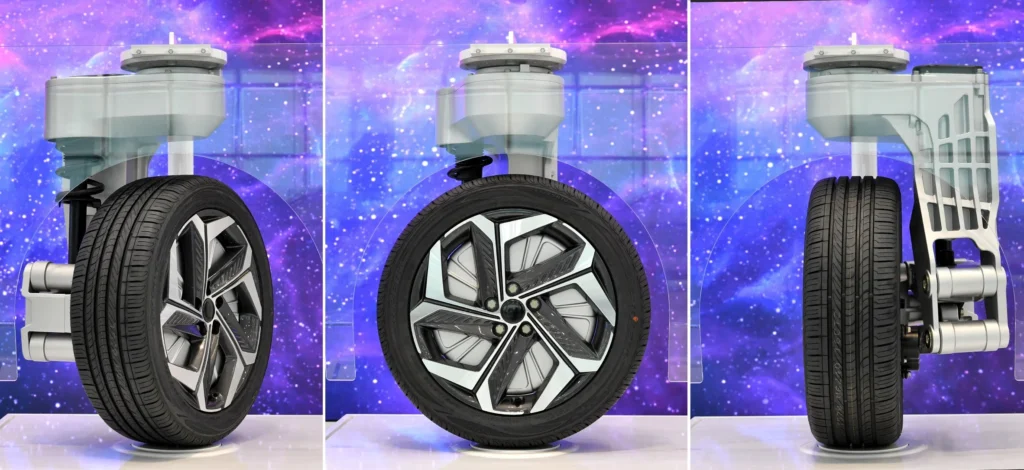90° Rotating Wheels of Hyundai Mobis Could Redefine How Vehicles Move!
Imagine your car moving sideways into a tight parking spot, spinning around in place, or gliding diagonally through traffic. Just like we used to see in cartoons. It’s the next chapter in urban mobility, brought to life by Hyundai Mobis and its e-Corner System.
In a world where electric vehicles are becoming mainstream and autonomous driving is still finding its rhythm, Hyundai Mobis has focused on solving a more immediate and relatable problem: urban maneuverability. With 90-degree rotating wheels, their vehicles can perform tasks that have traditionally frustrated drivers, like parallel parking or tight U-turns, with the kind of precision you’d expect from robots, not sedans.
As of 2025, this game-changing technology is moving towards reality, with production readiness expected by the end of this year.
What Is the e-Corner System of Hyundai Mobis?
First unveiled as a concept, Hyundai Mobis’ e-Corner System is a modular platform that allows independent 90-degree rotation of all four wheels. Each wheel integrates:
- Electric steering
- In-wheel electric motor
- Electronic brake system
- Electronic damper and suspension
This all-in-one design removes the need for mechanical linkages like drive shafts or traditional steering columns. Instead, everything is controlled digitally through drive-by-wire technology. This means the car can:
- Crab walk sideways into a parking spot
- Pivot turn like a tank
- Diagonal drift around corners
- Zero-turn to rotate in place
In essence it’s a new way to think about motion itself.

Real-World Use Cases: Designed for Urban Chaos
What makes this tech special isn’t just the novelty. It’s a real-world utility.
Imagine city cars or taxis that can:
- Park in tight spots without reversing
- Navigate narrow alleys or crowded urban zones
- Make 90-degree turns in one move
- Reduce accident risk during low-speed maneuvers
For fleet vehicles, the implications are even bigger: faster drop-offs, smarter loading angles, and greater spatial efficiency in warehouses or delivery hubs.
Hyundai Mobis has already demonstrated the system on a modified IONIQ 5 prototype. With a simple command, the car executed complex moves that would stump most human drivers without changing its size, ground clearance, or footprint.
Production by 2025: From Concept to Commercialization
Unlike many concept technologies, Hyundai Mobis has set a clear roadmap. Begin commercialization by late 2025.
In recent updates, the company confirmed that e-Corner is moving past the experimental stage and into mass-production readiness. The first wave will likely debut in next-gen EVs under Hyundai’s umbrella, but the larger goal of Mobis is to license the system to global OEMs, allowing carmakers to integrate it into a range of models, from smart urban cars to autonomous fleets.
Yes, this is a tech flex but also it is a part of Hyundai Mobis’ “Move Improved” campaign, a brand-level push to redefine how we think about movement, not just transportation.
Are There Any Real Competitors?
Not really, not at this scale or integration level.
While others have teased similar motion features, they’re mostly limited in scope:
- GMC Hummer EV: Offers “crab walk” mode but uses complex mechanics rather than modular e-corners
- Rivian R1T: Showcased a tank turn but pulled it from production due to technical and environmental challenges
- REE Automotive: Pioneering corner modules for EVs but recently paused production to re-strategize toward software licensing
Hyundai Mobis is the only company with a production timeline, real-world testing, and full vertical integration across hardware, software, and vehicle architecture.
Can this be the next breakthrough after Self-Driving Cars?
While autonomous driving has captured public imagination, the rollout remains fragmented due to legal, ethical, and technological hurdles. By contrast, Hyundai’s e-Corner innovation addresses an immediate, daily problem: maneuverability in dense urban spaces.
This technology could be deployed in:
- Compact city EVs
- Last-mile delivery vehicles
- Smart taxi fleets
- Commercial vehicles in logistics parks or smart cities
It makes human-driven cars smarter and easier to handle, even before autonomy fully takes over.
The Futurism Today’s Take
At The Futurism Today, we cover what’s next in mobility, and Hyundai Mobis’ 90-degree wheels feel like a quiet revolution. The e-Corner system challenges us to rethink how vehicles should move in modern cities, where space is scarce and agility is the ultimate advantage.
In a world obsessed with speed, Hyundai Mobis is making a case for smart movement. If this technology hits the streets by late 2025, it won’t just help us park better. It might help cities move better too. Because sometimes, driving is about moving smarter not faster.

